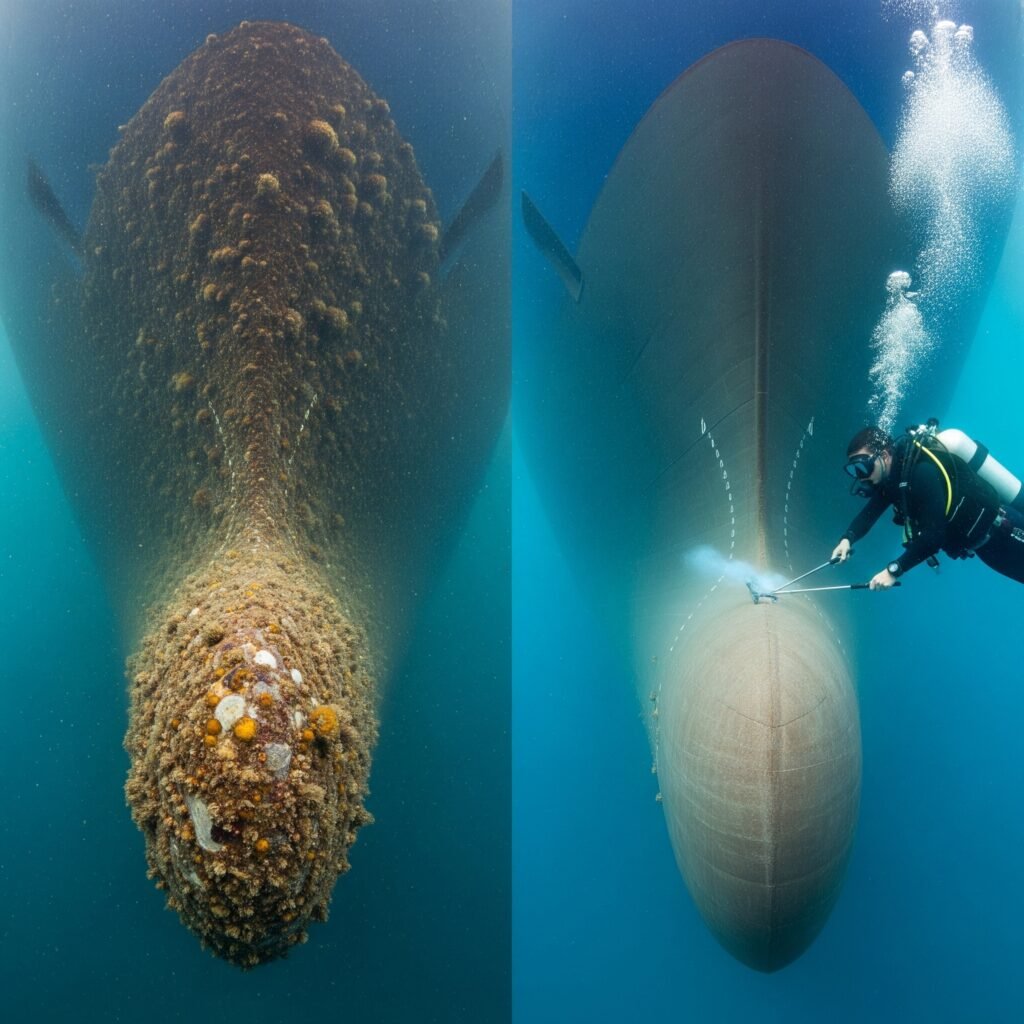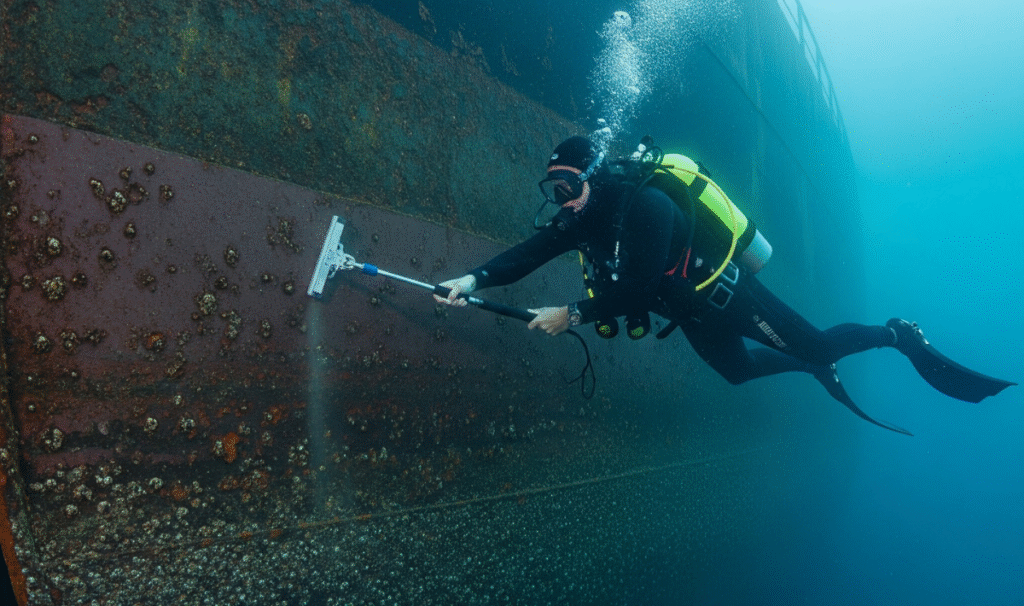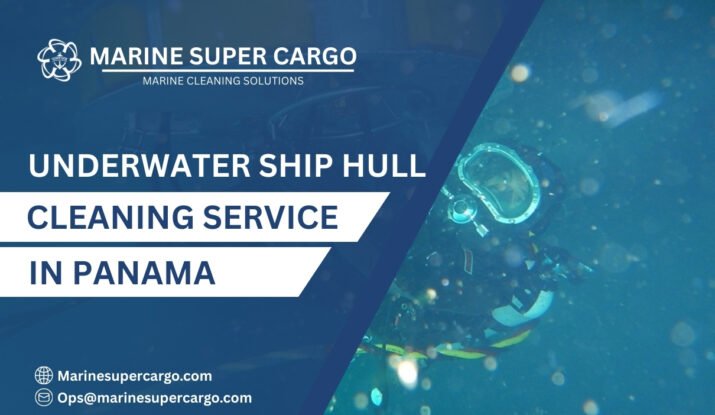When you hear “Panama,” chances are the Panama Canal comes to mind—the engineering marvel linking the Pacific and Atlantic Oceans. This narrow waterway has reshaped world trade, allowing vessels to shorten voyages by thousands of kilometers.
But with great maritime importance comes constant marine traffic. And every ship that passes through Panama’s waters eventually battles the same persistent issue: biofouling. That’s where underwater ship hull cleaning in Panama plays a starring role.
This isn’t just routine maintenance—hull cleaning is a strategic safeguard for efficiency, safety, and sustainability. Let’s uncover the underwater ship hull cleaning in Panama and why it’s essential for shipowners navigating this global crossroads.
What Exactly is Underwater Ship Hull Cleaning in Panama?
Over time, barnacles, algae, and microorganisms cling to ship hulls. This buildup, called biofouling, increases friction, slows down vessels, and forces engines to burn more fuel.
Underwater hull cleaning involves divers or robotic cleaners working below the waterline—scrubbing, brushing, and polishing hulls using specialized tools. In underwater ship hull cleaning in Panama, the process is often conducted by trained marine professionals in compliance with international standards to ensure both efficiency and ecosystem safety.
Improved Fuel Efficiency and Cost Reduction
The Drag Dilemma: How Biofouling Increases Resistance
Think of driving a car with mud-caked tires—you’ll need more fuel just to move forward. Likewise, a heavily fouled hull drastically increases resistance in water. According to shipping studies, biofouling can bump up fuel consumption by as much as 40%.

Unlocking Fuel Savings with a Clean Hull
With underwater ship hull cleaning in Panama, ships regain their streamlined efficiency. Engines work less, fuel bills shrink, and voyages become faster. For vessels transiting the Panama Canal—where delays can turn costly—this efficiency is more than an advantage; it’s a necessity.
For shipowners juggling large fleets, these savings compound into millions annually, making hull cleaning one of the smartest maintenance investments possible.
Ensuring Vessel Safety and Longevity
Corrosion and Damage Prevention
Marine organisms don’t just hitch a ride—they trap moisture against steel surfaces, accelerating corrosion. Over time, coatings peel, metals weaken, and ships risk structural issues.
Routine underwater ship hull cleaning in Panama prevents this by eliminating growth before lasting damage occurs. This translates into fewer unexpected repairs and a much longer service life for vessels.
Compliance with Global Safety Standards
The International Maritime Organization (IMO) demands strict adherence to safety protocols. Fouled hulls can cause inspection failures and even operational bans in certain regions.
Regular hull cleaning, especially in international hubs like Panama, ensures ongoing compliance while also guaranteeing vessel readiness.
Reducing Greenhouse Gas Emissions
According to imo.org, shipping is responsible for nearly 3% of global carbon emissions. But efficiency is deeply tied to emissions. A smooth hull means less drag, less fuel, and lower CO₂ emissions.
By investing in underwater ship hull cleaning in Panama, shipowners contribute directly to emission reduction goals while reaping economic benefits.
Stopping the Spread of Invasive Marine Species
The MARPOL Convention warns about the risks of biological transfers through ship hulls. Tropical waters like Panama’s create a high risk of species “hitchhiking” across oceans to disrupt other ecosystems.
Cleaning ensures organisms aren’t unintentionally transported, keeping ecosystems—both in Panama and abroad—safe from invasive threats.
The Global Role of the Panama Canal
The Panama Canal is one of the busiest maritime passages worldwide. Ships naturally stop at Panamanian ports for refueling, crew changes, or waiting slots. Adding underwater ship hull cleaning in Panama to that checklist saves operators time and reduces long-term operating costs.
Skilled Workforce and Well-Equipped Facilities
Panama’s maritime sector follows best practices supported by imca-int.com and iaphworldports.org. From specialized diving teams to modern marine technology, hull cleaning here is performed at world-class standards so that vessels remain compliant globally.
Step-by-Step Cleaning Journey
- Pre-Inspection – Divers or ROVs (remotely operated vehicles) examine hull conditions.
- Cleaning Phase – Fouling removed using brushes, water jets, or cavitation systems.
- Polishing – Smooth surfaces restored for optimal performance.
- Debris Containment – Prevent the release of organisms back into the environment.
- Final Report – Documentation provided for operators and regulatory compliance.
Tools and Technology Deployed
Panama increasingly relies on robotic cleaners, suction filtration, and eco-friendly cleaning tools. This blend of tech and skilled manpower ensures that underwater ship hull cleaning in Panama is fast, effective, and sustainable.
Frequent Fouling in Tropical Waters
Panama’s warm tropical seas make it a hotspot for marine growth, meaning biofouling happens faster here than in colder regions. Ships stopping longer in Panamanian ports often experience rapid fouling, necessitating frequent cleaning.
Balancing Frequency with Costs
Over-cleaning wears down protective coatings; under-cleaning spikes fuel use. Most experts recommend underwater ship hull cleaning in Panama every 6–12 months, striking the balance between efficiency and cost.

Eco-Friendly Cleaning Innovations
The maritime sector is moving towards coatings free of harmful chemicals and cleaning methods that capture and dispose of fouling waste responsibly. Panama, with its location at a global trade hub, is well-positioned to embrace these techniques.
AI and Robotics in Marine Maintenance
Expect to see AI systems predict fouling build-up, with underwater drones executing cleanings autonomously. The future of underwater ship hull cleaning in Panama will be smarter, safer, and greener, led by innovation.
Conclusion
Beneath Panama’s world-famous waters, vessels quietly gain—or lose—efficiency. Hull cleaning may not be flashy, but its benefits are substantial. The three key advantages of underwater ship hull cleaning in Panama are clear:
- Fuel and cost savings by reducing drag.
- Greater safety and durability for vessels.
- Environmental protection, with fewer emissions and less spread of invasive species.
For shipowners navigating one of the world’s busiest maritime gateways, hull cleaning is not optional—it’s essential. By partnering with experts like CleanShip.co, opera
FAQ:
Q1. How often should underwater ship hull cleaning be performed in Panama?
Every 6–12 months, though tropical waters around Panama may require more frequent cleaning.
Q2. Can hull cleaning damage coatings?
Not if performed by trained professionals—modern methods protect coatings while eliminating growth.
Q3. Does hull cleaning really save fuel?
Yes. Cleaner hulls reduce drag, allowing ships to burn less fuel and move faster.
Q4. Why is Panama a strategic location for hull cleaning?
Because vessels already stop here for the canal transit, it’s convenient and cost-effective to schedule cleaning during port calls.
Q5. How does hull cleaning help the environment?
Underwater ship hull cleaning in Panama reduces fuel-related emissions and prevents invasive organisms from spreading across global waters.


